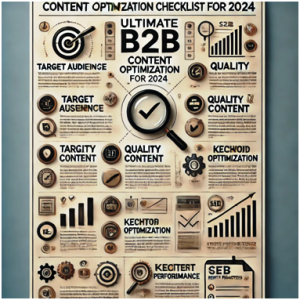A high-quality SEO implementation is the key to B2B content optimisation. According to a study by First Page Sage, effective campaigns offer an SEO ROI of 748%, indicating that businesses receive an average of $7.48 on every dollar. This figure applies to various sectors, with B2B enterprises seeing ROIs as high as 702%.
In today’s competitive B2B market, content optimisation has gone from a valuable tool to a vital driver of engagement, lead nurturing, and conversions. Optimised content improves search engine results, increases brand trust, and accelerates growth.
However, creating well-optimised content creates obstacles. Many B2B organisations struggle to reach the correct audience, remain relevant in a rapidly changing industry, and achieve a high search presence. Common barriers include matching content with customer personas, handling complicated search intent, and developing precise keyword strategies.
This checklist provides a simplified, step-by-step process to assist B2B enterprises in overcoming these issues. Each part, from keyword research to sophisticated analytics, is intended to improve search performance and audience value while showcasing your business as an industry leader.
Understanding Your Audience and Search Intent
To create B2B content that effectively resonates with your target audience, you must first understand their specific requirements and search intent at each point of the buyer journey. Such an understanding entails determining your audience and the precise information they are looking for.
Catering to your audience enables you to create content that addresses their difficulties and goals directly. This technique increases engagement, establishes trust, and correctly promotes conversions.
In today’s B2B scene, SEO is a significant priority among numerous marketers. Over 50% of B2B marketers identify organic search as their primary marketing approach, attributing most leads to organic traffic. This emphasis on SEO outperforms other techniques, such as organic social media (43%) and video marketing (21%). (Source: DataBox Study)

Defining Buyer Personas for B2B
The first step in B2B content optimisation that resonates with your target audience is conducting thorough research on buyer personas. Doing so entails determining the primary demographics, job functions, industry, and unique difficulties or pain points encountered by various decision-makers inside a company.
B2B buyer personas may contain stakeholders, including managers, executives, and operational teams, each with aims and concerns. For example, a C-suite executive may prioritise ROI and scalability. Still, a mid-level manager may favour efficiency and simplicity of implementation.
Segmenting the audience based on criteria such as industry, company size, or position in the purchase decision process helps you to adapt content to these specific pain points and objectives. Detailed buyer personas outline how you approach each group, whether through case studies, data-driven insights, or in-depth product demos.
Mapping Search Intent across Buyer Journey
Any competitive and relevant B2B content must address specific types of search intent. In contrast to B2C content, B2B content is frequently tailored to multi-stage purchasing procedures aimed at decision-makers who want particular information along their buyer’s journey.
Common B2B search intents include:
- Informational purpose: Users with this purpose are in the early phases of inquiry, looking to understand an issue better or investigate alternative solutions. The content on this page should be educational and insightful. Examples of informative searches include “how to enhance supply chain efficiency” and “best software for HR automation.”
- Commercial Intent: Users are researching and assessing various brands or items. At this point, the material should emphasise distinguishing characteristics and benefits to help in comparison. Examples of searches include “best project management tools for tech companies” and “HR software for mid-sized enterprises.”
- Transactional Intent: Users exhibiting transactional intent are prepared to purchase or contact a sales team. Product price, demos, and clear calls to action are all common examples of effective content at this level. Examples of search phrases include “enterprise CRM software pricing” and “schedule a demo for marketing automation.”
Aligning content with these precise search intentions ensures that each item efficiently answers audience demands throughout their journey.

Keyword Research for B2B Content Optimisation
Keyword research is an essential component of an effective B2B content strategy. It aligns your audience’s search behaviour with your company objectives.
Importance of High-Intent Keywords
As per Statista research, 66% of B2B buyers initiate their search journey on search engines. As such, finding and prioritising high-intent keywords that meet industry issues, pain points, and goals is critical.
In contrast to B2C, B2B keyword campaigns must account for lengthy sales cycles, intricate buyer journeys, and many decision-makers.
Effective keyword research increases visibility, attracts quality prospects, and builds confidence by establishing your company as a trusted resource in decision-making. By concentrating on focused terms corresponding to specific stages of the buyer’s journey, businesses may attract high-intent visitors, engage decision-makers, and reach demonstrable outcomes.
The section below delves into the crucial components of B2B keyword research, such as identifying long-tail prospects, exploiting competitive analysis, and developing tactics that turn traffic into paying customers.

Targeting Long-Tail Keywords for Niche Audiences
In business-to-business markets, specificity is critical. Long-tail keywords (phrases with three or more words) are beneficial for targeting specialist terms and industry-specific searches relevant to potential clients. For example, instead of using the broad phrase “project management software,” a B2B company may target “project management software for IT consulting firms.”
Long-tail keywords can attract visitors looking for specialised answers, suggesting a greater willingness to interact. They are also less competitive than broad keywords, helping you rank higher and engage with prospects seeking specific solutions that meet their needs. Tools like AnswerThePublic and Google’s Keyword Planner can help you uncover niche keywords that address these unique pain concerns.
Competitive Keyword Analysis
Analysing the terms that rivals rank for lets you quickly learn what connects with your target audience. Tools like SEMrush and Ahrefs may help you complete a competitive study by exposing rival keywords, expected traffic, and ranking difficulties.
- Begin by identifying the significant rivals in your field. Then, employ these tools to compile a list of the top-performing keywords.
- Please pay particular attention to the long-tail keywords they rank for and any content gaps that may be filled with new views or value-added resources.
- Focus on keywords with moderate competition but where you’ve got a unique insight or angle to offer—the approach above can ensure that you are not only competing but also carving out a distinct space for the brand you represent.
Incorporate Buyer Journey Stages
By mapping keywords to the stages of the B2B buyer journey—awareness, deliberation, and decision—you ensure that you encounter prospective clients at every point in their decision-making process.
- Prioritise informational keywords during the awareness stage, such as “how to boost supply chain efficiency” or “what is ERP software.” These keywords attract customers throughout the research process, allowing you to develop brand recognition by establishing your company as a reliable source of information.
- During the selection stage, look for comparative terms like “top ERP software for SMEs” or “best CRM for B2B sales.”
- Finally, in the decision stage, include product-specific and proactive keywords such as “purchase ERP software for logistics” or “B2B CRM provider demo,” which will encourage prospects to convert.
Crafting Optimised Content Structure
Developing an optimal structure in content creation is critical for B2B companies looking to capture readers and search engines. An organised, understandable layout improves the user experience, and guarantees improved SEO ranks. The essential features listed below can help you structure content properly, address user intent, and position your material as highly useful in B2B.
Using Headers and Subheaders for B2B Engagement
Ranking high in Google’s organic search results is critical for attracting audience attention since the #1 result has a 27.6% click-through rate (CTR), rendering it 10x more likely to get clicked over the #10 result. (Source: Backlinko Use Behaviour Study)
Effective search engine optimisation boosts exposure and stimulates user interaction. Well-structured headers for busy B2B audiences divide the content into logical, scannable, increasing readability and search engine rankings.
Begin with a Clear H1 Header
Begin with an appealing H1 header that contains the primary keyword and establishes the post’s main topic. The H1 tag is critical for both search engines and users because it quickly signals the goal and relevancy of the content.
Organise Content with H2 and H3 Headers
Work with H2 and H3 headers to provide an explicit content hierarchy. These headers improve readability and SEO by logically grouping parts, helping readers explore the material more effectively.
H2 Examples: Introduce important parts of broad themes, such as “Key Benefits of Content Optimisation for B2B,” using H2 headers.
H3 Examples: Below each H2, insert H3 headers that delve further into specific points, such as “Improved Engagement” and “Enhanced Conversions.” This tiered structure keeps readers interested while also allowing search engines to understand the complexity and arrangement of your material.
Why Headers Matter for SEO and Readability?
Organised headers help SEO by indicating relevance and subject structure to search engines, boosting your chances of appearing better in search results. Headers also help readers skim and access material, which is especially important for B2B audiences looking for rapid, actionable information.
Crafting Compelling Introductions and Conclusions
In the competitive arena of B2B content, grabbing and maintaining the reader’s interest is critical.
According to academic research, website visitors just needs 50 milliseconds (0.05 seconds) to establish a perception about your website. For some, their initial impression of the website is the sole impression that they’ll ever have of your business.
Strong beginnings are critical for increasing engagement by establishing the relevance of the content and promoting continued reading. Similarly, a well-written ending directs readers to the next step while confirming your brand as a valuable and trustworthy resource. Businesses prioritising these factors can improve user experience and boost their online presence.
Engaging Introductions: Hooking the Reader
The introduction is a chance to capture readers and demonstrate your content’s significance.
Begin by tackling the reader’s major pain concerns, such as the difficulties of producing superior B2B leads or optimising content in specialised markets. By addressing these problems, you instantly connect with your audience and demonstrate empathy for their challenges.
Next, briefly describe the solutions the content will bring, portraying the post as a helpful source of practical insights tailored to their needs. This strategy engages readers and gives them confidence that they have found a trustworthy, solution-oriented resource.
Impactful Conclusions: Summarising and Inspiring Action
The conclusion should restate the primary lessons while condensing the critical elements into a summary. Doing so gives readers a clear idea of what they’ve learned and how to apply it.
To increase reader engagement, encourage them to take action—whether by applying the recommendations presented or researching further resources.
By portraying your business as a supportive partner in resolving their difficulties, you create a good image that may foster loyalty and trust.
Crafting User-Friendly Content for B2B Audiences
For B2B audiences, a smooth and fast user experience is essential.
Statistics reveal that 88% of visitors avoid going back to slow-loading websites, emphasising the importance of fast-loading webpages that rank high in search results. Typically, top-ranked sites load in 1.65 seconds.
However, speed alone is insufficient; content structure and clarity are essential for engaging and retaining B2B readers, who prefer brief and precise responses to their inquiries.
- For a logical, user-friendly experience, arrange content gradually.
- Start with broad concepts to lay the groundwork and address overarching themes first.
- Move towards specifics gradually and delve into particular insights to provide an easy shift from general to complicated content.
- Visual formatting tools improve reading and understanding.
- Bullet Points are ideal for step-by-step processes or outlining essential points, making text more accessible to scan and understand.
- Numbered lists are helpful for sequences, ensuring readers follow the information flow correctly.
- Tables are ideal for feature comparison or detailing plans side by side, providing a convenient marker for decision-makers.

On-Page SEO Best Practices for B2B Content
On-page SEO components for B2B content, such as meta titles, descriptions, headers, and image alt tags, must be written with a thorough awareness of B2B-specific keywords and industry terminology.
Meta Titles and Descriptions
Begin with straightforward, keyword-focused, and action-oriented meta titles. Instead of using a general term like “Product Management Tools,” use “Enterprise Product Management Tools for Agile Teams.” This title contains keywords relevant to B2B search intent and is intended to attract decision-makers.
The meta description is also vital for grabbing user interest across search results. Create descriptions that highlight the content’s usefulness to business users, using phrases like “solutions for [industry]” or “designed for [target role].” B2B searchers can be encouraged to click by including an intriguing call-to-action, such as “Explore solutions that enhance your team’s productivity.”
Image Optimisation with Alt Text
Define image alt tags in a manner relevant to the content’s B2B context. If your story includes data charts or product pictures, ensure the alt text accurately describes each graphic, such as “analytics dashboard for sales reporting.” It will not only improve accessibility but also increase the relevancy of picture searches.
Internal Linking SEO Strategy
An effective internal linking strategy links similar themes direct users across your website and increases content importance in search engines’ eyes.
Internal links in B2B should direct users to information that expands on their expertise or provides more profound insights. Blog entries should include links to relevant service sites, case studies, or industry guidelines for additional inquiry.
Ensure the anchor text appropriately conveys the connected information when adding internal links. For example, if you say “data management solutions,” direct users to a specific website about your data management solutions or a relevant white paper. These improve user navigation and increase session time, demonstrating greater engagement with search engines.
Schema Markup for B2B Content Optimisation
Schema markup is an effective strategy for improving search engines’ comprehension and showcasing of your content, particularly on B2B sites that give structured data about services, goods, and customer evaluations.
Use the Product, Organization, or Service schema types to specify the fundamental information about your products and firm concisely. For example, integrating schema markup to the service pages helps search engines better understand your offers, allowing them to appear in search results as rich snippets.
If you offer consulting services, utilise schema characteristics to identify your industry, region, and service type. Similarly, product pages should include information such as product characteristics, price, and customer feedback. This organised data makes your sites stand out, especially in B2B searches where comprehensive, relevant information is highly prized.

Ensuring Content Readability and Accessibility
Readability and accessibility are critical components of B2B content optimisation to ensure your message connects with professionals from all sectors.
Here’s a checklist to help you improve these characteristics in your content.
1. Formatting Content for Readability
Begin by concentrating on clarity and professionalism.
- While B2B audiences frequently have expertise in the field, avoiding unnecessary jargon is critical, as it may repel confident readers. Instead, use concise, plain language that conveys competence without being overpowering.
- Use short, straightforward language and break down complex topics into manageable chunks. A glossary of industry-specific words helps make the text accessible. Tools like Hemingway Editor can help you assess readability and balance simplicity and professionalism.
2. Incorporating Visual Aids
B2B issues are frequently complicated; therefore, visual aids may help make information more understandable.
- Infographics, for example, are suitable for condensing data-heavy ideas in a visually appealing style. In contrast, charts may better depict patterns and comparisons than text alone.
- Videos may also be an effective tool for delving further into complicated topics, providing explanations or demos that captivate visually oriented consumers.
- Continuously optimise graphics with alt text to render them accessible for mobile readers. It will benefit visually challenged people and improve SEO.
Mobile and Accessibility Optimization
With B2B professionals frequently viewing content on several devices, mobile-friendly design are essential.
- Implement responsive design principles to guarantee that information scales well on smartphones and tablets, allowing easy reading.
- Accessibility should also be prioritised: utilise suitable contrast ratios for text and background colours, caption videos, and arrange information with headers for simple navigation.
- Meeting online accessibility standards (such as WCAG 2.1) can help make your material accessible to all audiences, increasing your reach and improving user experience.
Enhancing Content Quality for B2B Audiences
Publishing high-quality, helpful content is essential to any effective B2B content optimisation strategy.
For content to appeal to B2B audiences, it must go above surface-level information and include actionable insights, practical examples, and evidence-based suggestions that address the difficulties and demands of industry professionals.
This section includes critical components that improve content quality and relevance, ensuring it resonates with readers and promotes your company as a trustworthy expert.
Leveraging Expert Insights and Case Studies
Using professional opinions and case studies in your posts is critical for building authority and trust in the B2B arena.
Real-world examples from your customer success stories demonstrate how your solutions operate in practice and provide tangible evidence of your expertise. Case studies with vivid before-and-after scenarios help readers understand how comparable tactics or solutions may meet their problems.
Consider including expert input from industry leaders or in-house expertise. Such insights can tackle current trends, identify difficulties, or make forecasts, enhancing your content’s informative and thought-provoking value. Customise examples and case studies to your audience’s industry or difficulties to connect fully, increasing relevance and relatability.
Regular Content Audits for Relevance
In today’s fast-changing B2B market, material may quickly become obsolete. Routine content audits are critical for maintaining relevance and value. A full audit entails analysing your existing content collection to uncover obsolete data, references, or material irrelevant to current market trends.
By updating material with new insights and data, you exhibit a dedication to accuracy and dependability, which B2B users respect greatly. Furthermore, content audits provide a chance to discover underperforming material that may benefit from improvement. These involve altering keywords to match search intent, improving readability, or reorganising the structure for greater clarity.
Audits guarantee your information remains current, visible, and authoritative.
Differentiating Your Content
In a competitive B2B environment, standout content covers industry-specific problem areas and solutions. Instead of focusing on broad issues, investigate particular areas or difficulties rarely addressed. Doing so also includes explaining complicated procedures, correcting common industry misunderstandings, or offering innovative solutions based on your product or service knowledge.
To further differentiate your material, try providing users with tools or resources such as templates, guidelines, or downloadable files. Visual components like infographics and data visualisations also help make complex material more understandable and entertaining. Concentrating on precise, actionable advice and unique insights allows you to develop content that delivers value and establishes your company as an industry leader.
Boosting Engagement and Conversations
For engagement and conversion, B2B content optimisation shifts readers along the sales funnel. Effective engagement methods keep potential clients on the page longer and boost the possibility of conversions by directing them to the appropriate subsequent actions. Here’s how to maximise engagement and conversion rates.

Crafting Strategic CTAs
B2B content requires well-placed, properly designed Calls to Action (CTAs). These CTAs should be clear, detailed, and highly relevant to the content and the user’s steps in the purchasing process.
Avoid generic prompts like “Learn More” or “Click Here” and provide more valuable activities. For example, if a reader reads a technical guide or case study, a CTA urging them to “Request a Demo” or “Download the Full Whitepaper” is more appropriate.
B2B organisations may encourage meaningful interactions that create trust and enhance conversion rates by connecting the CTA with concrete tasks, such as arranging consultations or accessing in-depth information.
Using Lead Capture Forms and Gated Content
Try including gated material at appropriate spots throughout your content to acquire qualified leads.
Gated material, such as whitepapers, reports, or extensive case studies, offers users valuable information in return for their contact information. However, it is critical to strike a balance when using gated material; excessive gating might discourage interaction, whereas targeted gating can draw in readers who are more involved and likely to convert.
Create lead capture forms that are simple and easy to fill. These forms often ask for basic information such as name, email, and firm size or role. Place forms at organic breakpoints, such as at the end of a blog article or during valuable insights sections, to enhance completion rates while preserving the user experience.
Personalizing Content for Specific Audiences
Personalisation has revolutionised B2B content optimisation.
Using insights from prior interactions and visitor data, we may deliver personalised suggestions that are incredibly relevant to the user’s needs. For example, suppose the visitor has already downloaded a cloud software case study. In that case, tailored content suggestions for similar product demos or cloud integration papers might help them make a more informed decision.
Integrating dynamic content blocks that respond to the user’s browsing history or industry might provide a more relevant experience, making consumers feel understood and appreciated. This degree of customisation increases engagement and trust, as customers think the company understands their specific demands.
Case Study: RealVantage – Content Optimisation Success
RealVantage, a real estate investing platform, used B2B content optimisation tactics to get 2300+ monthly visitors worth SCG 1,310. Their objective was to inform potential investors on industry trends and techniques while overcoming hurdles in providing content that attracted and converted leads in a specific market.
Key Strategies
- Keyword Targeting: Extensive research revealed long-tail keywords such as “real estate fractional ownership” and “institutional real estate investing” to reach a specific audience.
- On-Page Optimisation: Keywords were used in headers, meta descriptions, and alt texts to improve readability through organised forms.
- Content Authority: RealVantage established itself as a trusted industry leader by providing comprehensive, data-driven insights that addressed investor concerns.
- Internal and External Links: Internal links help navigation and external links to reputable sites increase SEO and domain authority.
- User Engagement: Strategically positioned CTAs increased sign-ups and consultations, resulting in conversions.
Results
RealVantage experienced considerable traffic growth, improved brand positioning, and increased engagement, illustrating the transformative power of strategic content optimisation for B2B organisations. This strategy emphasises the need to produce high-quality, authoritative information to achieve long-term development and competitive advantage.

Analysing and Iterating for Continuous Improvement
B2B content optimisation requires a solid approach to assessing performance and implementing data-driven enhancements to perform well. Here’s a methodology for ensuring your content consistently increases engagement and conversions.
Key Metrics to Track Performance
Tracking particular metrics is critical for determining how effectively your content resonates with the B2B audience.
The three key metrics to pay attention to are:
- Bounce Rate: High bounce rates suggest visitors do not find your content entertaining or relevant. Try to keep this level low by optimising the introductions and employing internal connections to stimulate additional research.
- Time on Page: This number measures how long consumers interact with your site’s content. A significant time on the page indicates that the information is helpful, informative, and fits the reader’s needs. In contrast, a low one may suggest that it falls short.
- Conversion Rate: In B2B, conversions can include form submissions, email sign-ups, or demo requests. Tracking this demonstrates how efficiently your content contributes to your leads and company objectives.
Tools for Measuring Success
Analytics tools may provide a detailed perspective of user activity. Google Analytics offers basic information about bounce rate, traffic, and conversions. Still, Hotjar uses heatmaps and session records to provide a more in-depth view of user interaction. These tools work together to help you monitor what works and where you can improve.
Implementing Data-Driven Optimisations
Start by utilising tools like Google Analytics or HubSpot to determine critical performance measures like traffic, engagement, conversion, and bounce rates. Analyse this data to identify patterns, such as content styles that increase engagement, themes with strong conversion potential, or pages with exceptionally high exit rates.
Take targeted and informed actions, such as updating failing content with newer facts or more enticing CTAs, repurposing top-performing articles into new forms like infographics or films, and refining keyword strategy to enhance search ranks. A/B tests crucial components like headlines, graphics, and CTA locations to see what works best for your audience.
Wrap Up
Effective B2B content optimisation requires a science and an art mindset, and this checklist has walked you through the critical components necessary to stand out in today’s competitive environment.
We’ve examined how to identify your audience and their goals, conduct strategic keyword research, create a well-structured and compelling content layout, prepare for SEO, and regularly assess and iterate to improve. Each phase ensures that your content generates significant interaction, fulfils search intent, and turns prospects into leads.
Now, it’s time for you to put this information into practice. Begin applying each checklist item to notice genuine changes in your content’s performance. Adopting this methodical strategy can increase brand exposure, generate high-quality leads, and position your organisation as a trusted leader.
At Leading Solution, we specialize in delivering exceptional digital marketing services tailored to your unique needs. Whether you’re seeking an experienced SEO agency for top-tier SEO services or a trusted partner for e-commerce SEO, our team is here to help. We also offer local SEO services to boost your visibility within your community and web development expertise to create stunning, functional websites. Explore our SEO packages in Singapore to find the right solution for your business goals. Let’s work together to achieve success online.


